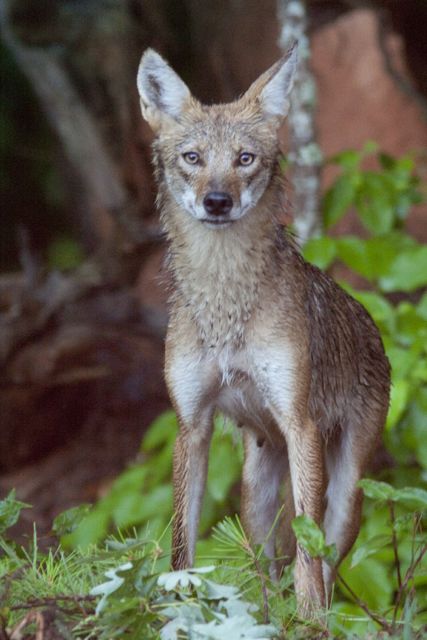|
| Distribution |
In NC, now (2022) occurs over essentially all of the state, and presumably is present in all 100 counties. Some local introductions in the state are also documented and have helped to spread the species in the state.
Formerly, prior to the middle 20th Century, they occurred mainly from the middle parts of the continent westward to the Pacific Coast. By around 1980, Coyotes were still poorly known from NC, with relatively few records. However, the species has quickly spread to the Atlantic coast, and by about 2015 had spread to all NC counties. |
| Abundance |
Increasing fairly rapidly in the state. Now, it is fairly common to common over most of the state, perhaps least numerous in the southeastern counties and on barrier islands. Coyote tracks are not difficult to find in many places, and roadkills are becoming more frequent, clear signs of an increase in the population in our state. (Details of abundance within various parts of the state are not well documented.) The N.C. Natural Heritage Program recently moved the State Rank to S5, a measure of how numerous it now is in the state. Note that the iNaturalist website contains photos for more than half of the state's counties, and the editors have not taken the time to update the map with "Photo" records/documentation unless the county had previously no known records (white on the map). |
| Seasonal Occurrence |
Occurs year-round. |
| Habitat |
The species has spread eastward as a result of large-scale land-clearing, and thus they favor a mosaic of forested areas and farmlands and fields. Forests should have denning areas such as thickets, rocky places, and other dense cover. Thus, its habitat is rather similar to that of the Red Fox in the state.
See also Habitat Account for Exotic Invaded Habitats |
| Behavior |
Coyotes are nocturnal and crepuscular feeders, infrequently seen abroad during daylight hours, though typically seen in daylight slightly more often than are fox species. They hunt singly or as pairs, almost never in groups (in the East). Though their wailing, yapping calls are frequently heard in the West, such calling seems to be infrequent in the East. |
| Comments |
The spread of the species into NC and other Eastern states has been astonishingly quick. Prior to about 1990, people were lucky to see a live or dead Coyote in NC, but now roadkills can be seen a few times a year by observant biologists. Tracks are often found in dirt or mud, as well, by those knowledgeable about such animal signs. |
| Origin |
Native |
| NC List |
Official |
 State Rank State Rank |
S5 |
| State Status |
|
 Global Rank Global Rank |
G5 |
| Federal Status |
|
| subspecies |
Canis latrans latrans |
| other_comName |
|
| synonym |
Canis lupus latrans |



